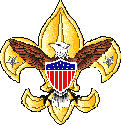| MERIT BADGES |
|
|
|
|
| Note: Eagle Required are in Italics |
"A"
American
Business
American Culture
American Heritage
American Labor
Animal Science
Archaeology
Archery
Architecture
Art
Astronomy
Athletics
Atomic Energy
Auto Mechanics
Aviation
"B"
Backpacking
Basketry
Bird Study
Bugling
"C"
Camping
Canoeing
Chemistry
Cinematography
Citizenship
Community*
Citizenship Nation*
Citizenship World*
Climbing
Coin Collecting
Collections
Communications*
Computers
Cooking
Crime Prevention
Cycling*
"D"
Dentistry
Disability Awareness
Dog Care
Drafting
"E"
Electricity
Electronics
Emergency
Preparedness**
Energy
Engineering
Entrepreneurship
Environmental
Science*
"F"
Family Life*
Farm Mechanics
Fingerprinting
Fire Safety
First Aid*
Fish & Wildlife Mgmt.
Fishing
Fly Fishing
Forestry
"G"
Gardening
Genealogy
Geology
Golf
Graphic Arts
"H"
Hiking
Home Repairs
Horsemanship
"I"
Indian Lore
Insect Studies
"J"
Journalism
"K"
"L"
Landscape Architecture
Law
Leatherwork
Lifesaving**
"M"
Mammal Study
Medicine
Metalwork
Model Design & Building
Motorboating
Music
"N"
Nature
"O"
Oceanography
Orienteering
"P"
Painting
Personal Fitness**
Personal Management*
Pets
Photography
Pioneering
Plant Science
Plumbing
Pottery
Public Health
Public Speaking
Pulp and Paper
"Q"
"R"
Radio
Railroading
Reading
Reptile & Amphibian Study
Rifle Shooting
Rowing
"S"
Safety
Salesmanship
Scholarship
Sculpture
Shotgun Shooting
Skating
Skiing
Small Boat Sailing
Soil & Water
Conservation
Space Exploration
Sports**
Stamp Collecting
Surveying
Swimming**
"T"
Textile
Theatre
Traffic Safety
Truck Transportation
"U"
"V"
Veterinary Medicine
"W"
Water Skiing
Weather
Whitewater
Wilderness Survival
Wood Carving
Woodwork
"X"
"Y"
"Z"
|
|
- Do ONE of the following:
- From a set point (stake, nail, etc.), measure a range line north 300 feet and south 300 feet. From the same point, measure a base line east 300 feet and west 300 feet. From one or more points (stations) marked along the range and/or base line, take compass readings to trees, shrubs, and rocks. Take measurements from the range or base line to the located features. Make the measurements using instruments, methods, and accuracy consistent with the current technology, as directed by your counselor.
- Find and mark the corners of a five-sided lot that has been laid out by your counselor to fit the land available. Set an instrument over each of the corners and record the angle turned between each line and the distance measured between each corner, as directed by your counselor. With the assistance of the counselor, compute the error of closure from the recorded notes. The error of closure must not be more than 5 feet. From the corners, take compass readings or turn angles to trees, shrubs, and rocks and measure to them. All measurements should be made using instruments, methods, and accuracy's consistent with current technology, as directed by your counselor.
- From the field notes gathered for requirement 1, draw to scale a map of your survey (as directed by your counselor). Submit a neatly drawn copy.
- Use one of the corner markers from requirement 1 as a benchmark with an assumed elevation of 100 feet. Using a level and rod, determine the elevation of the other four corner markers.
- Without first measuring the distance, determine the length between two points, then measure the length using a tape or instruments consistent with current technology. The answer you first determined must be within 5 percent of the length measured.
- Determine the height of a point (tree limb or the like) that can be checked using a tape or level rod. Check the height using instruments and methods consistent with current technology, as directed by your counselor. Your original determination must be within 5 percent of the measured height.
- Discuss the importance of surveying with a licensed surveyor or another qualified individual. Also discuss the various types of surveying and mapping, and applications of surveying technology to other fields. Discuss career opportunities in surveying and related fields. Discuss qualifications preparation for such a career.
|
||||||
Last Update May 15, 2023

.jpg)

 Surveying
Surveying